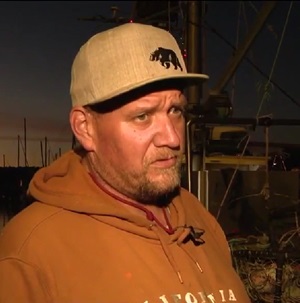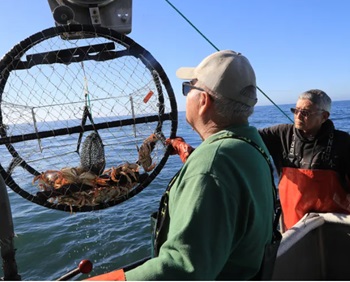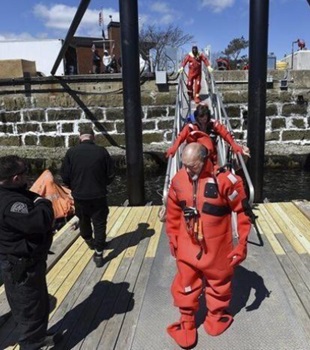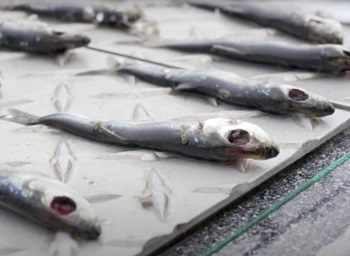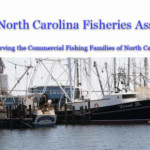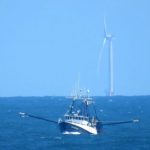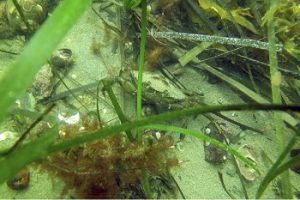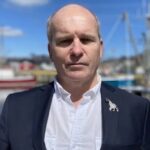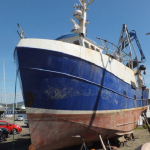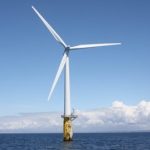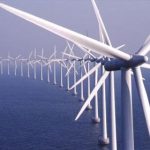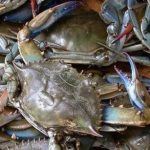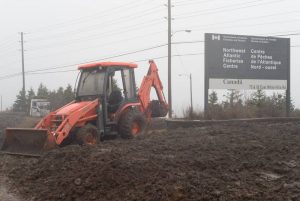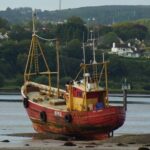Category Archives: Pacific
Fishermen and community leaders react to Trident announcement to sell a third of its Alaska plants
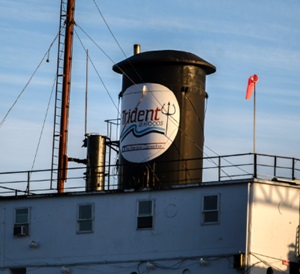 Gerry Cobban Knagin is a commercial fisherman. She and her family have fished around Kodiak and sold their harvest to Trident Seafoods, one of the largest seafood processors in the country, on and off for decades. But on Dec. 12, the company announced it’s selling off about a third of its Alaska processing plants, including their year-round facility in Kodiak. She said the announcement was a huge shock for almost everyone on the island. “Speaking with [Trident] management, there wasn’t any heads up for anyone,” Knagin said. “And they decided, according to management, that they wanted full transparency so that the fleet would know.” Photos, more, >>click to read<< 20:44
Gerry Cobban Knagin is a commercial fisherman. She and her family have fished around Kodiak and sold their harvest to Trident Seafoods, one of the largest seafood processors in the country, on and off for decades. But on Dec. 12, the company announced it’s selling off about a third of its Alaska processing plants, including their year-round facility in Kodiak. She said the announcement was a huge shock for almost everyone on the island. “Speaking with [Trident] management, there wasn’t any heads up for anyone,” Knagin said. “And they decided, according to management, that they wanted full transparency so that the fleet would know.” Photos, more, >>click to read<< 20:44
CDFW Opens Commercial Dungeness Crab Fishery in Northern Management Zone, Continues Commercial Fishery Delay in Central Management Area.
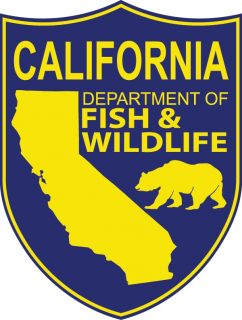 The California Department of Fish and Wildlife (CDFW) will open the commercial Dungeness crab fishery from the Oregon state line to the Sonoma/Mendocino county line (Fishing Zones 1 and 2) under a Fleet Advisory beginning Jan. 5, 2024 at 12:01 a.m. with a 64-hour pre-soak to begin on Jan. 2, 2024 at 8:01 a.m. The commercial fishery will remain delayed from the Sonoma/Mendocino county line to the U.S./Mexico border (Fishing Zones 3, 4, 5 and 6) until at least the next risk assessment due to elevated numbers of humpback whales resulting in increased entanglement risk. CDFW is also continuing the temporary recreational crab trap restriction from the Sonoma/Mendocino county line to Lopez Point, Monterey County, more, >>click to read<< 17:29
The California Department of Fish and Wildlife (CDFW) will open the commercial Dungeness crab fishery from the Oregon state line to the Sonoma/Mendocino county line (Fishing Zones 1 and 2) under a Fleet Advisory beginning Jan. 5, 2024 at 12:01 a.m. with a 64-hour pre-soak to begin on Jan. 2, 2024 at 8:01 a.m. The commercial fishery will remain delayed from the Sonoma/Mendocino county line to the U.S./Mexico border (Fishing Zones 3, 4, 5 and 6) until at least the next risk assessment due to elevated numbers of humpback whales resulting in increased entanglement risk. CDFW is also continuing the temporary recreational crab trap restriction from the Sonoma/Mendocino county line to Lopez Point, Monterey County, more, >>click to read<< 17:29
Major ‘climate deception’ lawsuit against Big Oil voluntarily dismissed
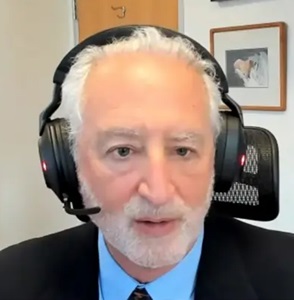 A major years-long lawsuit alleging that Big Oil companies have waged a disinformation campaign about the impacts of climate change was voluntarily dismissed by plaintiffs in a victory for the U.S. energy industry. The California-based Pacific Coast Federation of Fishermen’s Associations (PCFFA), the largest trade association of commercial fishermen on the West Coast, requested the dismissal in a filing with the U.S. District Court for the Northern District of California. The request came after Judge Vince Chhabria ruled on Nov. 1 that the case could be heard in federal court despite PCFFA’s argument for it to be tried in state court. Video, more, >>click to read<< 17:46
A major years-long lawsuit alleging that Big Oil companies have waged a disinformation campaign about the impacts of climate change was voluntarily dismissed by plaintiffs in a victory for the U.S. energy industry. The California-based Pacific Coast Federation of Fishermen’s Associations (PCFFA), the largest trade association of commercial fishermen on the West Coast, requested the dismissal in a filing with the U.S. District Court for the Northern District of California. The request came after Judge Vince Chhabria ruled on Nov. 1 that the case could be heard in federal court despite PCFFA’s argument for it to be tried in state court. Video, more, >>click to read<< 17:46
Commercial crabbing start pushed into 2024
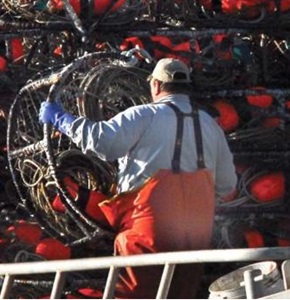 Dungeness crab in the vicinity of the mouth of the Columbia are still only inching their way toward the proportion of meat required before commercial harvest is allowed, delaying the season again. Fishery managers decided on Dec. 18 to push out the season start to Dec. 31, Jan. 15 or Feb. 1. They will meet Dec. 20 to settle on which date crabbers will be allowed to drop their pots, with deliveries back to port typically occurring around 72 hours later. Samples gathered Dec. 17 found south Pacific County crab had 20.7% recoverable meat, up from 19.4% meat on Nov. 28. Clatsop County crab tested at 22.9%, just shy of the mandatory minimum meat recovery criteria of 23% north of Cascade Head, and up from 21.1% on Nov. 29. more, >>click to read<< 14:30
Dungeness crab in the vicinity of the mouth of the Columbia are still only inching their way toward the proportion of meat required before commercial harvest is allowed, delaying the season again. Fishery managers decided on Dec. 18 to push out the season start to Dec. 31, Jan. 15 or Feb. 1. They will meet Dec. 20 to settle on which date crabbers will be allowed to drop their pots, with deliveries back to port typically occurring around 72 hours later. Samples gathered Dec. 17 found south Pacific County crab had 20.7% recoverable meat, up from 19.4% meat on Nov. 28. Clatsop County crab tested at 22.9%, just shy of the mandatory minimum meat recovery criteria of 23% north of Cascade Head, and up from 21.1% on Nov. 29. more, >>click to read<< 14:30
The Harbor Fish Co. is Gig Harbor’s next-gen fishing family
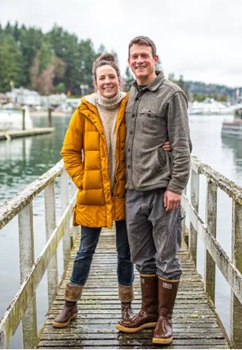 Wild, packed with nutrients, and heart-healthy. For Gig Harbor residents, a local fishing family provides direct delivery of fresh wild Alaskan-caught salmon to your doorstep. Alex James and Zack Worrell launched their company, The Harbor Fish Co., in 2022 to connect Gig Harbor with high-quality wild-caught Alaskan salmon, Dungeness crab, and striped shrimp harvested from the pristine and icy waters of southeast Alaska. The company is anchored in Gig Harbor and Juneau, Alaska. “We started it because we wanted to get a good product to our community. Food is such a great way to bring people together,” explains Alex. Inspired by their connection to the sea, she believes their fishing business can help “nourish the community” with “wild, sustainable, and nutritious food.” She also encourages consumers to learn more about their food. photos, links, more, >>click to read<< 09:50
Wild, packed with nutrients, and heart-healthy. For Gig Harbor residents, a local fishing family provides direct delivery of fresh wild Alaskan-caught salmon to your doorstep. Alex James and Zack Worrell launched their company, The Harbor Fish Co., in 2022 to connect Gig Harbor with high-quality wild-caught Alaskan salmon, Dungeness crab, and striped shrimp harvested from the pristine and icy waters of southeast Alaska. The company is anchored in Gig Harbor and Juneau, Alaska. “We started it because we wanted to get a good product to our community. Food is such a great way to bring people together,” explains Alex. Inspired by their connection to the sea, she believes their fishing business can help “nourish the community” with “wild, sustainable, and nutritious food.” She also encourages consumers to learn more about their food. photos, links, more, >>click to read<< 09:50
Dungeness Crab Season Delayed Again, SF Crabbers Miss Holiday Haul
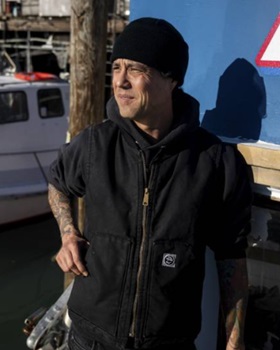 For decades, fishers have earned a living selling Dungeness crab out of San Francisco’s Fisherman’s Wharf. But many, like Shawn Chen Flading, have struggled over the last five years as the state has consecutively delayed the commercial season. “Every delay is difficult. Right now, I have zero income as a fisherman,” Flading said. The season, which has historically started on Nov. 15, is delayed until at least New Year’s Day to protect migrating humpback whales. Crabbers like Flading hope to catch the tail end of the holidays to recoup what they’ve lost. “It’s something people like to splurge on to create a feast,” Flading said. “But with the delay, we’ve lost all the holiday markets.” Photos, more, >>click to read<< 13:37
For decades, fishers have earned a living selling Dungeness crab out of San Francisco’s Fisherman’s Wharf. But many, like Shawn Chen Flading, have struggled over the last five years as the state has consecutively delayed the commercial season. “Every delay is difficult. Right now, I have zero income as a fisherman,” Flading said. The season, which has historically started on Nov. 15, is delayed until at least New Year’s Day to protect migrating humpback whales. Crabbers like Flading hope to catch the tail end of the holidays to recoup what they’ve lost. “It’s something people like to splurge on to create a feast,” Flading said. “But with the delay, we’ve lost all the holiday markets.” Photos, more, >>click to read<< 13:37
Commercial Fisherman Peter Allen Zuanich of Anacortes, Washington has passed away
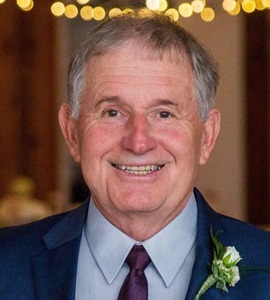 Peter Allen Zuanich was born September 3, 1946, in Bellingham, Washington. He passed away peacefully on November 24, 2023, in Oak Harbor, Washington, with his wife, Kimberly, by his side. Peter graduated from Bellingham High School and Central Washington University. Though he graduated with a degree in business, he ultimately followed in his father’s wake, working for many years as the owner and captain of commercial fishing vessels along the coasts of Alaska and California. A celebration of life will take place at 1pm on Sunday, Jan. 7, 2024, at The Boathouse in Zuanich Point Park. more, >>click to read<< 08:05
Peter Allen Zuanich was born September 3, 1946, in Bellingham, Washington. He passed away peacefully on November 24, 2023, in Oak Harbor, Washington, with his wife, Kimberly, by his side. Peter graduated from Bellingham High School and Central Washington University. Though he graduated with a degree in business, he ultimately followed in his father’s wake, working for many years as the owner and captain of commercial fishing vessels along the coasts of Alaska and California. A celebration of life will take place at 1pm on Sunday, Jan. 7, 2024, at The Boathouse in Zuanich Point Park. more, >>click to read<< 08:05
Hoyle’s Bill to Support Commercial Fishing in Port Infrastructure Act Passes
 This week 4th District Congresswoman Val Hoyle’s “Supporting Commercial Fishing in Port Infrastructure Projects Act” passed both the House and Senate as part of the Maritime Administration Reauthorization Act. A release from Hoyle said President Biden is expected to sign the bill into law. Hoyle said H.R.4618 will ensure ports can apply for infrastructure grants that support commercial fishing, bolster jobs and drive the economies of coastal communities. Hoyle said current law does not make it explicitly clear whether ports can apply for Port Infrastructure Development Program grants that support commercial fishing, often leaving it up to interpretation that can overlook commercial fishing communities who are the backbone of coastal economies. more, >>click to read<< 14:44
This week 4th District Congresswoman Val Hoyle’s “Supporting Commercial Fishing in Port Infrastructure Projects Act” passed both the House and Senate as part of the Maritime Administration Reauthorization Act. A release from Hoyle said President Biden is expected to sign the bill into law. Hoyle said H.R.4618 will ensure ports can apply for infrastructure grants that support commercial fishing, bolster jobs and drive the economies of coastal communities. Hoyle said current law does not make it explicitly clear whether ports can apply for Port Infrastructure Development Program grants that support commercial fishing, often leaving it up to interpretation that can overlook commercial fishing communities who are the backbone of coastal economies. more, >>click to read<< 14:44
Coast Guard urges safety precautions in advance of Dungeness Crab season
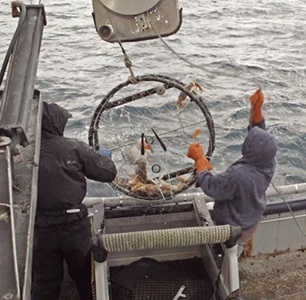 Oregon’s commercial Dungeness crab fishery opens Dec. 16 from Cape Foulweather, just south of Depoe Bay, to the California border, according to the Oregon Department of Fish and Wildlife (ODFW). The Coast Guard is urging mariners to take safety precautions in advance of the season, which in the past is historically followed by a spike in search and rescue cases involving commercial fishing vessels. Most major marine casualties involving the loss of life or loss of a vessel occurs during Dungeness Crab season for an array of reasons including unavailability of lifesaving equipment, poor weather conditions, and fatigue. more, >>click to read<< 15:08
Oregon’s commercial Dungeness crab fishery opens Dec. 16 from Cape Foulweather, just south of Depoe Bay, to the California border, according to the Oregon Department of Fish and Wildlife (ODFW). The Coast Guard is urging mariners to take safety precautions in advance of the season, which in the past is historically followed by a spike in search and rescue cases involving commercial fishing vessels. Most major marine casualties involving the loss of life or loss of a vessel occurs during Dungeness Crab season for an array of reasons including unavailability of lifesaving equipment, poor weather conditions, and fatigue. more, >>click to read<< 15:08

Project Salmon Claus delivers Christmas to children along the Columbia River
For 11 years, Officer Jerrod Daniel has delivered gifts to children living at tribal fishing sites along the Columbia River. For some children there, Salmon Claus delivers the only Christmas gifts they receive. Members of the public can donate to the program until this Friday, While helping put a smile on people’s faces never gets old, one story in particular stands out for him. During a long day of delivering gifts along the river, Daniel met a young girl, about 8 years old. He handed her a wrapped present and unlike many of the children around her, she did not open it right away. When Daniel asked her why, she smiled and said “I’m going to save it so I have something to open on Christmas.” more, >>click to read<<09:47
Sonoma County snags disaster relief designation for salmon fishery devastation
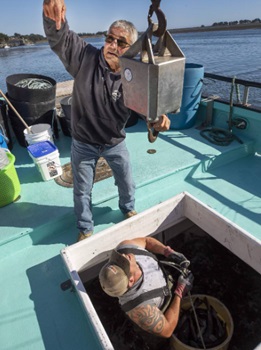 “Small businesses in Sonoma County that rely on salmon fishing for their livelihood were devastated when the fishery was shut down,” said county Supervisor Lynda Hopkins, whose district encompasses the Sonoma Coast. Hopkins added the business loans are intended “to help them recover. The SBA also lists other, bordering counties, with the presumption that those “may have suffered economic injury as well.” These include Napa, Marin, Solano, Mendocino and Lake. “We have lost 80% of our fleets in the last 40 years,” said Glen Spain, executive director of the Pacific Coast Federation of Fishermen’s Associations, which manages about a dozen fishing groups. He defined California’s $45 million fishing industry as being especially hard hit with state Fish and Wildlife’s permits dropping from 7,744 in 1980 to 1,006 this year. “These loans are trying to keep people intact as much as possible,” Spain said. photos, more, >>click to read<< 14:38
“Small businesses in Sonoma County that rely on salmon fishing for their livelihood were devastated when the fishery was shut down,” said county Supervisor Lynda Hopkins, whose district encompasses the Sonoma Coast. Hopkins added the business loans are intended “to help them recover. The SBA also lists other, bordering counties, with the presumption that those “may have suffered economic injury as well.” These include Napa, Marin, Solano, Mendocino and Lake. “We have lost 80% of our fleets in the last 40 years,” said Glen Spain, executive director of the Pacific Coast Federation of Fishermen’s Associations, which manages about a dozen fishing groups. He defined California’s $45 million fishing industry as being especially hard hit with state Fish and Wildlife’s permits dropping from 7,744 in 1980 to 1,006 this year. “These loans are trying to keep people intact as much as possible,” Spain said. photos, more, >>click to read<< 14:38
Caring Community: Newport Fishermen’s Wives seeking donations
 Dear Community Partner, The Newport Fishermen’s Wives is a non-profit organization of fishermen’s wives, mothers, daughters, and friends, supporting a strong sense of community helping to further the causes of industry, safety, seafood education, and family support. Through the support of our community partners, we are able to provide a number programs to our fishing community such as an Emergency Fund (for local fishing tragedies) and funeral support, Fishermen’s Memorial Sanctuary, Holiday Outreach for fishing families, scholarship funds and the Blessing of the Fleet community lunch and boat parade. more, >>click to read<< 12: 06
Dear Community Partner, The Newport Fishermen’s Wives is a non-profit organization of fishermen’s wives, mothers, daughters, and friends, supporting a strong sense of community helping to further the causes of industry, safety, seafood education, and family support. Through the support of our community partners, we are able to provide a number programs to our fishing community such as an Emergency Fund (for local fishing tragedies) and funeral support, Fishermen’s Memorial Sanctuary, Holiday Outreach for fishing families, scholarship funds and the Blessing of the Fleet community lunch and boat parade. more, >>click to read<< 12: 06
For Sale
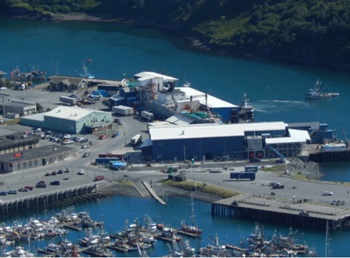 In the wake of a November warning that the entire industry is in trouble because of global market conditions, Trident Tuesday announced that it was launching a “comprehensive restructuring initiative” that called for “streamlining” and modernizing its 49th state operations. Or, in other words, it is trying to offload a third of its 12 processing operations, including one of the biggest. Industry insiders had been forecasting significant changes in one of the state’s main industries since processors paid high prices for a record run of Bristol Bay sockeye in 2022 only to be left holding the bag as both demand and prices dropped. But major downsizing by Trident, which has long promoted itself as “Anchored in Alaska,” still caught many by surprise. more, >>click to read<< 06:27
In the wake of a November warning that the entire industry is in trouble because of global market conditions, Trident Tuesday announced that it was launching a “comprehensive restructuring initiative” that called for “streamlining” and modernizing its 49th state operations. Or, in other words, it is trying to offload a third of its 12 processing operations, including one of the biggest. Industry insiders had been forecasting significant changes in one of the state’s main industries since processors paid high prices for a record run of Bristol Bay sockeye in 2022 only to be left holding the bag as both demand and prices dropped. But major downsizing by Trident, which has long promoted itself as “Anchored in Alaska,” still caught many by surprise. more, >>click to read<< 06:27
California’s Central Valley Chinook Are Getting Lost on Their Way Home
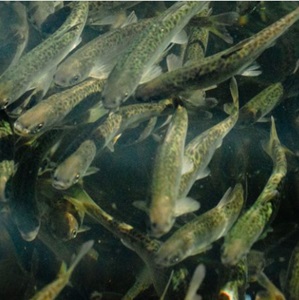 Picture yourself: a chinook salmon in the prime of your life. You dart through the water off California’s central coast, winding through kelp and dodging hungry sea lions. Long, sleek and silver, dappled with dark spots. Eyes wide and vigilant. More than 20 kilograms of pure muscle. You’ve been out at sea for several years now, first voyaging north along the Oregon coastline, then westward into deeper water. As winter approaches and the days grow shorter, you’ve found your way back to California. You’ve felt the seasons turn before, but this year, it means something special. Your kind, the Central Valley chinook—what fishers call the king salmon—are not born at sea. For thousands of years, your ancestors began their lives in the heart of California, where tributaries and streams flow together to form the mighty Sacramento and San Joaquin Rivers. photos, >>click to read<< 08:31
Picture yourself: a chinook salmon in the prime of your life. You dart through the water off California’s central coast, winding through kelp and dodging hungry sea lions. Long, sleek and silver, dappled with dark spots. Eyes wide and vigilant. More than 20 kilograms of pure muscle. You’ve been out at sea for several years now, first voyaging north along the Oregon coastline, then westward into deeper water. As winter approaches and the days grow shorter, you’ve found your way back to California. You’ve felt the seasons turn before, but this year, it means something special. Your kind, the Central Valley chinook—what fishers call the king salmon—are not born at sea. For thousands of years, your ancestors began their lives in the heart of California, where tributaries and streams flow together to form the mighty Sacramento and San Joaquin Rivers. photos, >>click to read<< 08:31
California Dungeness crab season on hold again, fishermen losing out big
Dungeness crab season is on hold again. There are a lot fewer fishing boats at Pillar Point Harbor in Half Moon Bay these days. A high number of migrating humpback whales and a recently confirmed leatherback sea turtle, the largest turtle in the world, being caught in Dungeness crab fishing gear, according to the California Department of Fish and Wildlife, has caused the state to prevent crab traps from being used once again. “Absolutely criminal ’cause they’re not solving the problem by keeping us tied to the dock,” Matthew Paul, who has been crabbing along the California coast for four decades.”That’s about six bucks to the public,” Rick Hauschel explained the price of a crab held in his hands, after lifting one out of a tank on his boat, the Polaris. Video, photos, >>click to read<< 06:59
Where will the whales be? Ask the climate model
In a new study, scientists say they can now use global temperature models, commonly used in climate science, to predict up to a year in advance when hot ocean temperatures will raise the risk of whale entanglements. This lead time could allow state regulators, fishers and other businesses that depend on the fishery, as well as Californians hoping for a Dungeness crab holiday meal, to plan ahead for potential fishing restrictions. Ecological forecasts could help New England and maritime Canada, where highly endangered right whales are also getting entangled in fishing gear. “My personal opinion is that this is very, very helpful,” said Richard Ogg, a commercial fishing boat captain based in Bodega Bay. more, >>click to read<< 11:57
Bellingham’s shoreline history: A boom, bust of resource extraction
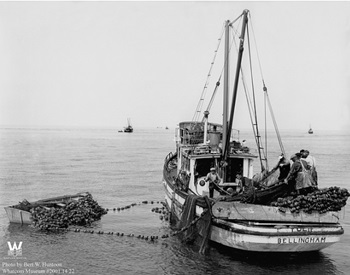 By 1890, the U.S. Census estimated approximately 18,500 people lived in Whatcom County. In the years that followed, additional lumber mills popped up. These included the Puget Sound Mill at the mouth of Padden Creek, the E.K. Wood Mill at Boulevard Park, and the Whatcom Falls Company (Loggie Mill) off Whatcom Creek. Pacific American Fisheries (PAF) first appeared in 1899 to process local salmon, eventually establishing the largest canning operation in the world. Both industries attracted large numbers of Asian immigrant workers, leading later to a significant shift in culture — along with significant racist worker backlash — in the region. The rich salmon runs also attracted canners and fishermen from Croatia, Finland and Ireland. Photos, >>click to read<< 09:20
By 1890, the U.S. Census estimated approximately 18,500 people lived in Whatcom County. In the years that followed, additional lumber mills popped up. These included the Puget Sound Mill at the mouth of Padden Creek, the E.K. Wood Mill at Boulevard Park, and the Whatcom Falls Company (Loggie Mill) off Whatcom Creek. Pacific American Fisheries (PAF) first appeared in 1899 to process local salmon, eventually establishing the largest canning operation in the world. Both industries attracted large numbers of Asian immigrant workers, leading later to a significant shift in culture — along with significant racist worker backlash — in the region. The rich salmon runs also attracted canners and fishermen from Croatia, Finland and Ireland. Photos, >>click to read<< 09:20
I’m Dreaming of a Crab Christmas: Dungeness Season opens Dec. 16 south of Cape Foulweather
 Oregon’s commercial Dungeness crab fishery opens Dec. 16 from Cape Foulweather, just south of Depoe Bay, to the California border. Targeted to open Dec. 1, Oregon’s ocean commercial Dungeness crab season can be delayed or partially opened so consumers get a high-quality product and crabs are not wasted. This year’s season was initially delayed until at least Dec. 16 due to low meat yield in some coastal areas. >>click to read<< 06:50
Oregon’s commercial Dungeness crab fishery opens Dec. 16 from Cape Foulweather, just south of Depoe Bay, to the California border. Targeted to open Dec. 1, Oregon’s ocean commercial Dungeness crab season can be delayed or partially opened so consumers get a high-quality product and crabs are not wasted. This year’s season was initially delayed until at least Dec. 16 due to low meat yield in some coastal areas. >>click to read<< 06:50
California’s commercial Dungeness crab season delayed yet again
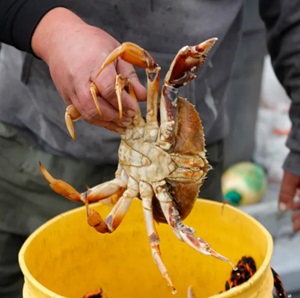 California’s commercial Dungeness crab season has once again been delayed, officials from the California Department of Fish and Wildlife announced. Delays in the crabbing season have been implemented to protect humpback whales and leatherback sea turtles, protected species that are sometimes entangled in crabbing lines and gear. Years of repeated delays and the cancellation of this year’s salmon season have hurt Santa Cruz fishermen financially, says Tim Obert, local commercial fisherman and president of the Santa Cruz Commercial Fishermen’s Association. “This year’s crab season is going to be some of the first income for these boats since last year’s crab season closed,” said Obert, noting that he has economically relied on the black cod fishery this year, instead of the usual salmon and Dungeness crab mainstays. more, >>click to read<< 13:54
California’s commercial Dungeness crab season has once again been delayed, officials from the California Department of Fish and Wildlife announced. Delays in the crabbing season have been implemented to protect humpback whales and leatherback sea turtles, protected species that are sometimes entangled in crabbing lines and gear. Years of repeated delays and the cancellation of this year’s salmon season have hurt Santa Cruz fishermen financially, says Tim Obert, local commercial fisherman and president of the Santa Cruz Commercial Fishermen’s Association. “This year’s crab season is going to be some of the first income for these boats since last year’s crab season closed,” said Obert, noting that he has economically relied on the black cod fishery this year, instead of the usual salmon and Dungeness crab mainstays. more, >>click to read<< 13:54
Bay Area business hauling in, washing boats for free as fishing industry struggles
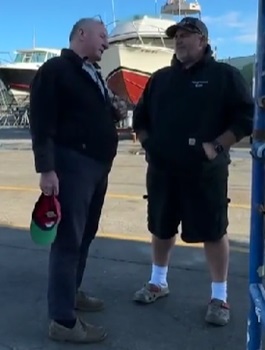 Local fishermen are getting a helping hand as they eagerly wait for the commercial Dungeness crab season. They didn’t get to fish salmon this year, and the presence of Humpback whales is delaying the crab season, causing them financial hardship. To help them, Paul Kaplan, for the first time since establishing Keefe Kaplan Maritime decades ago, is offering all Northern California fisherman hauling-in and power washing services free of charge. “They’re a vital part of our industry and supporting our craftsmen, and so I thought it was the right thing to do,” said Kaplan. Delayed starts and shortened seasons for crab fisherman have taken a toll on the livelihood of small businesses. “It’s becoming for most of us maxed credit cards and hoping that we get to go crabbing soon enough before they’re due. Everybody in the fleet is hurting,” said Brand Little. Video, more, >>click to read<< 13:11
Local fishermen are getting a helping hand as they eagerly wait for the commercial Dungeness crab season. They didn’t get to fish salmon this year, and the presence of Humpback whales is delaying the crab season, causing them financial hardship. To help them, Paul Kaplan, for the first time since establishing Keefe Kaplan Maritime decades ago, is offering all Northern California fisherman hauling-in and power washing services free of charge. “They’re a vital part of our industry and supporting our craftsmen, and so I thought it was the right thing to do,” said Kaplan. Delayed starts and shortened seasons for crab fisherman have taken a toll on the livelihood of small businesses. “It’s becoming for most of us maxed credit cards and hoping that we get to go crabbing soon enough before they’re due. Everybody in the fleet is hurting,” said Brand Little. Video, more, >>click to read<< 13:11
Hyde-Smith, Cotton & Scott Introduce Bill to Ban Chinese Seafood Imports
 WASHINGTON, D.C. – U.S. Senator Cindy Hyde-Smith (R-Miss.) today joined U.S. Senators Tom Cotton (R-Ark.) and Rick Scott (R-Fla.) in introducing legislation to ban U.S. imports of seafood and aquaculture products from China. The Ban China’s Forbidden Operations in the Oceanic Domain (Ban C-FOOD) Act would also sanction companies that import Chinese seafood and place tariffs on countries that facilitate the shipment of the seafood. “It’s past time we hold China accountable for its persistent violation of sovereign waters and its shameless use of slave labor to dominate the aquaculture market with unsafe, chemical-ridden products. more, >>click to read<< 09:01
WASHINGTON, D.C. – U.S. Senator Cindy Hyde-Smith (R-Miss.) today joined U.S. Senators Tom Cotton (R-Ark.) and Rick Scott (R-Fla.) in introducing legislation to ban U.S. imports of seafood and aquaculture products from China. The Ban China’s Forbidden Operations in the Oceanic Domain (Ban C-FOOD) Act would also sanction companies that import Chinese seafood and place tariffs on countries that facilitate the shipment of the seafood. “It’s past time we hold China accountable for its persistent violation of sovereign waters and its shameless use of slave labor to dominate the aquaculture market with unsafe, chemical-ridden products. more, >>click to read<< 09:01
Feds offer emergency loans to idled salmon industry
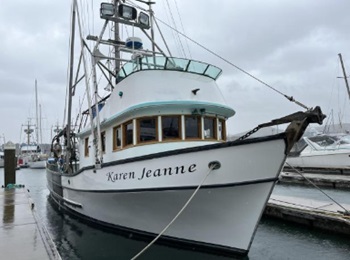 Last spring, the commercial chinook salmon season was completely cancelled. Now federal officials are offering emergency subsidized loans for an industry in crisis. The loans must be repaid over a 30-year term, though no payments are required over the first year. George Kostyrko, a spokesman for the federal Small Business Administration, or SBA, said the aid is meant to help a now struggling sector. “The closure has had an economic impact on the commercial and recreational fishing and those associated with the broader salmon fishing industry here on the west coast,” Kostyrko said. more, >>lick to read<< 06:50
Last spring, the commercial chinook salmon season was completely cancelled. Now federal officials are offering emergency subsidized loans for an industry in crisis. The loans must be repaid over a 30-year term, though no payments are required over the first year. George Kostyrko, a spokesman for the federal Small Business Administration, or SBA, said the aid is meant to help a now struggling sector. “The closure has had an economic impact on the commercial and recreational fishing and those associated with the broader salmon fishing industry here on the west coast,” Kostyrko said. more, >>lick to read<< 06:50
A group of commercial fishermen have ended up before the Supreme Court
 An unforgiving southeast wind cut across Cape May, New Jersey, on a recent Tuesday morning; the 50-mile-per-hour gusts were so strong they created white caps on a section of the bay here that is typically calm. There would be no fishing for Bill Bright and his crew. “We don’t have crop insurance. If the fish don’t show up, there’s no bailout,” the 64-year-old said, standing on the deck of the Eva Marie, an 88-foot-long fishing vessel used to catch herring. As a lifelong fisherman, Bright is used to slow days. But a recent shift in tidal fortunes here has nothing to do with fish and everything to do with the federal government. “What’s at stake for us is our future,” Bright said. For years, fishermen like Bill Bright and his colleague Wayne Reichle have been required to take federal observers on their boats when they set out into the North Atlantic in search of herring. Video , >>click to read<< 19:06
An unforgiving southeast wind cut across Cape May, New Jersey, on a recent Tuesday morning; the 50-mile-per-hour gusts were so strong they created white caps on a section of the bay here that is typically calm. There would be no fishing for Bill Bright and his crew. “We don’t have crop insurance. If the fish don’t show up, there’s no bailout,” the 64-year-old said, standing on the deck of the Eva Marie, an 88-foot-long fishing vessel used to catch herring. As a lifelong fisherman, Bright is used to slow days. But a recent shift in tidal fortunes here has nothing to do with fish and everything to do with the federal government. “What’s at stake for us is our future,” Bright said. For years, fishermen like Bill Bright and his colleague Wayne Reichle have been required to take federal observers on their boats when they set out into the North Atlantic in search of herring. Video , >>click to read<< 19:06
Athearn Marine Agency Boat of the Week: 92′ Rodriguez Scalloper/Shrimper
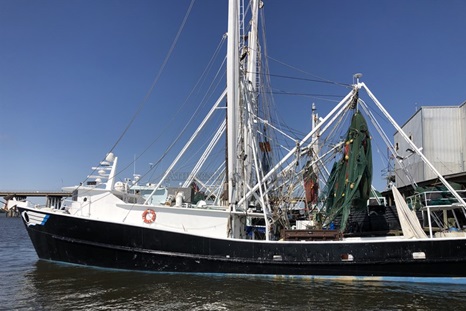 To review specifications, information, 35 photos’, and a video, >click here<, To see all the boats in this series, >click here< 10:50
To review specifications, information, 35 photos’, and a video, >click here<, To see all the boats in this series, >click here< 10:50
Dec. 16 set for commercial Dungeness crab season opening
 Oregon’s commercial Dungeness crab fishery opens Dec. 16 from Cape Foulweather, just south of Depoe Bay, to the California border, according to the Oregon Department of Fish and Wildlife (ODFW). Pre-season testing shows that crabs remain too low in meat yield to open commercial fishing from Cape Foulweather to the Washington border. The next round of crab meat yield and biotoxin testing will help determine if this area can open Dec. 31 or is further delayed. Oregon, California and Washington coordinate Dungeness crab quality testing and the commercial season opening dates. A history of Oregon’s commercial crab landings is available online. more, >>click to read<< 06:37
Oregon’s commercial Dungeness crab fishery opens Dec. 16 from Cape Foulweather, just south of Depoe Bay, to the California border, according to the Oregon Department of Fish and Wildlife (ODFW). Pre-season testing shows that crabs remain too low in meat yield to open commercial fishing from Cape Foulweather to the Washington border. The next round of crab meat yield and biotoxin testing will help determine if this area can open Dec. 31 or is further delayed. Oregon, California and Washington coordinate Dungeness crab quality testing and the commercial season opening dates. A history of Oregon’s commercial crab landings is available online. more, >>click to read<< 06:37
B.C. salmon farms linked to explosive spike in wild fish deaths
B.C. salmon farms killed more than 800,000 wild fish in 2022, 16 times more than the last decade’s yearly average, federal data shows. The unprecedented spike in aquaculture bycatch accounts for more dead fish in one year than the combined death toll over the previous 10 years. In one graphic example, video captured at a Cermaq facility in Clayoquot Sound shows herring floundering at the surface after getting sucked into a powerful machine meant to remove sea lice from farmed salmon. Stan Proboszcz, a senior scientist at Watershed Watch Salmon Society, said he has never seen anything like it. “All these herring that went through the hydrolicer had their eyes blown out,” Proboszcz said. “It’s horrific.” more, photos, >>click to read<< 18:07
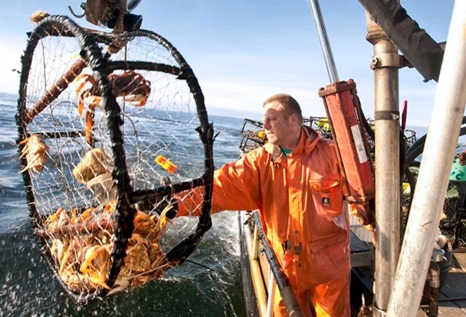
What makes Dungeness Crab Unique
Named after the town of Dungeness, Washington where people first began fishing for these crustaceans in the 1800s, Dungeness crab meat is prized by chefs and seafood connoisseurs alike for its subtle sweetness, and flaky, delicate texture. It’s easy to get lost in the moment when you’re biting into a chunk of delectable Dungeness crab meat. Still, it’s worth pausing to express gratitude toward the crab fishermen (and women) who caught that meal for you. This article covers a lot about these crabs, and you’ll know about a wide variety of crab from Dungeness to King Crab. Dungeness vs. Snow Crab, vs. Stone Crab, Photos, and more, >>click to read<< 16:50
‘Catalytic.’ How a bipartisan bill could save working waterfronts from Cape Cod to Alaska
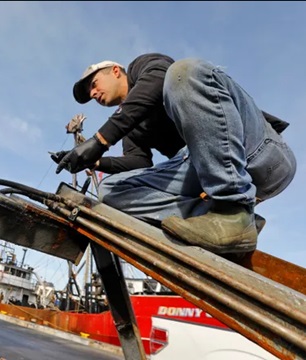
Andrew Spalt climbs the side of the new hydraulic dredge ramp he is installing aboard his boat Miss Emma.
The Working Waterfront Protection Act (S-3180) would establish a grant program that would support working waterfronts in coastal states, including the Great Lakes. The act would provide $20 million annually through fiscal 2028. Commercial fishing cooperatives, working waterfront owners and operators, nonprofit organizations and municipal and state governments would be eligible to apply. Fishing Communities Coalition Coordinator Noah Oppenheim said support is crucial because of pressures facing working waterfront owners and fishing communities nationwide. The coalition represents more than 1,000 independent small boat fishermen and business owners from Maine to Alaska, according to its website. 8 photos, more, >>click to read<< 09:38







